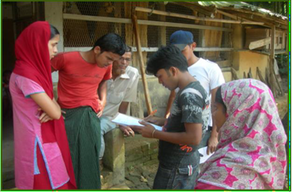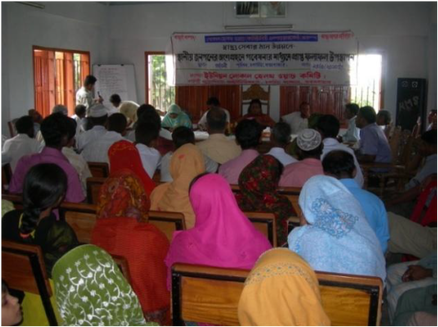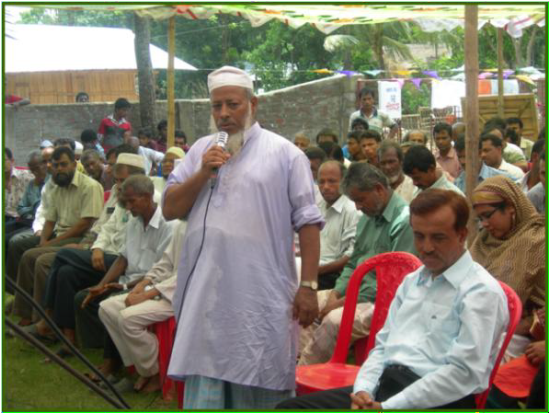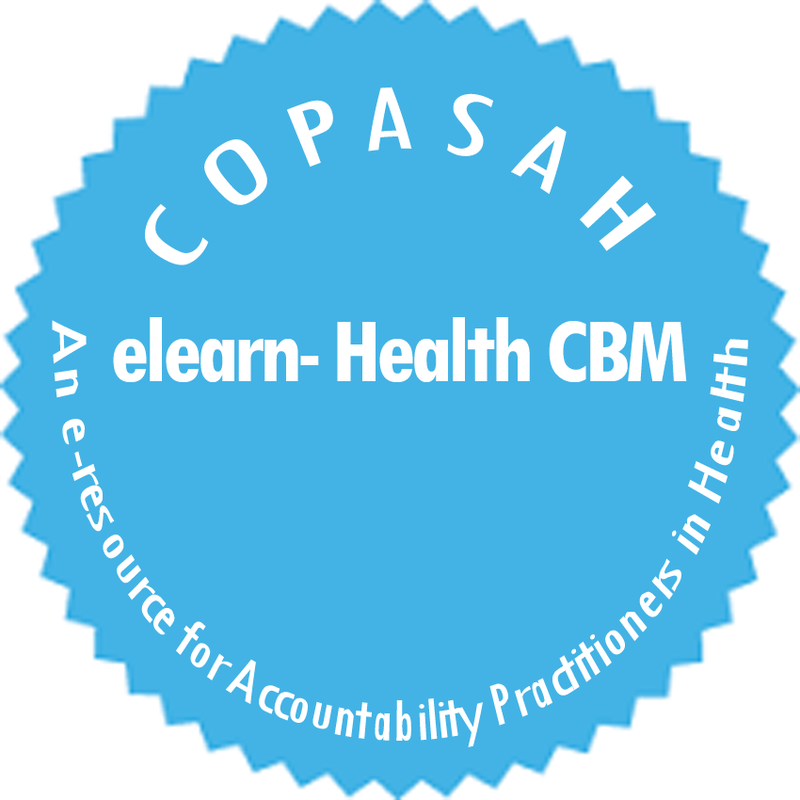
|
|
Community Monitoring for Health System Performance Towards Making Service Delivery Accountable for the People in Bangladesh
|
Shahidul Hoque
|
|
Background
Chakaria Community Health Project is being implemented in Chakaria, a south eastern sub-district of Cox‟s Bazar in Bangladesh since 1994. It is operationalised in partnership with the village based self-help organisations (SHOs) using participatory planning and implementation strategies for active engagement with the community in monitoring health related functions. The SHOs regularly meet and discuss the issues related to health service delivery and seek redressal from the public sector authorities. The organisation ICDDR,B initiated community empowerment and monitoring of the services through local health watches in 2007 |
The specific aims of the project were:
- To increase the accountability of the health system towards the community and local leadership by formation of local health watches.
- To empower communities by training them in monitoring, data compilation and interpretation techniques, and by increasing their knowledge on health and health systems.
- To measure the impact of the local health watches and community monitoring on the performance of the health system and its utilisation by people of diverse socio-economic groups.
Designing the process: The project was piloted in 3 unions of Chakaria, a remote rural area under Cox‟s Bazar district of Chittagong division in Bangladesh, which is a low performing area in terms of health and development indicators. The project took place over a two year period from January 2007 and was scaled–up in another 3 unions for two years up to December 2011. The project developed community empowerment tools for monitoring health services in three phases.
Phase one included engaging and rapport building and community discussion. In the second phase, community monitoring teams and progress review committees were formed, knowledge translation done and a monitoring plan was developed. In the third phase, analysis of data collected and sharing of the outcomes was done.
Phase one included engaging and rapport building and community discussion. In the second phase, community monitoring teams and progress review committees were formed, knowledge translation done and a monitoring plan was developed. In the third phase, analysis of data collected and sharing of the outcomes was done.
|
Phase 1: Rapport building and community discussion
At the initial stage of the process, union parishad members and other local leaders in the community in each of the intervention unions were contacted. (Note: union councils - union parishads or just unions - are the smallest rural administrative and local government units in Bangladesh. Each union is made up of nine wards. Usually one village is designated as a ward). Discussion meetings were held to generate and increase knowledge of community members regarding their health status, health needs and rights, health systems and to build bridges and facilitate better communication between the different stakeholders in the community. The process involved discussions on situation analysis of health in the community, to explore solutions to existing health issues and to formulate an action plan to improve the health services. The concept and the process of monitoring health services was part of these discussions too. Lists of likely candidates for participation in the community monitoring process, indicators for monitoring the use of facilities and quality of services were discussed by the community members. |
Some of the indicators discussed included: types of health problems faced by the community, demographic profile of people accessing health services (by gender, socio-economic status, age distance of dwelling from facility), availability of facilities, the barriers to utilization, etc. The union parishad members were made part of the core team to build leadership and to take the process forward and special attention was given to have a wide variety of representation.
Phase 2: a) Formation of community monitoring teams and progress review committee
Participants of community monitoring teams and leaders guiding these teams were selected during the course of meetings with the community and union parishad. Twelve community monitoring team members were selected from each union. A progress review committee (PRC) consisting of twelve leaders was formed in each union. The leaders included members of the union parishad as well as other community figures who were willing to contribute time and effort to the process.
In each union, the PRC was responsible for guiding the local community in the monitoring process and evaluating the impact of the monitoring process. The PRC accomplished this by coordinating the activities of the community monitoring team members through regular meetings, and by regularly sharing the information gathered with the community. The PRC received data and feedback from community groups. Finally, based on this feedback, the PRC made the necessary revisions to the monitoring techniques and communicated these with the monitoring teams.
Phase 2: a) Formation of community monitoring teams and progress review committee
Participants of community monitoring teams and leaders guiding these teams were selected during the course of meetings with the community and union parishad. Twelve community monitoring team members were selected from each union. A progress review committee (PRC) consisting of twelve leaders was formed in each union. The leaders included members of the union parishad as well as other community figures who were willing to contribute time and effort to the process.
In each union, the PRC was responsible for guiding the local community in the monitoring process and evaluating the impact of the monitoring process. The PRC accomplished this by coordinating the activities of the community monitoring team members through regular meetings, and by regularly sharing the information gathered with the community. The PRC received data and feedback from community groups. Finally, based on this feedback, the PRC made the necessary revisions to the monitoring techniques and communicated these with the monitoring teams.
|
b) Knowledge translation and developing monitoring plan
Information was collected through exit interviews outside each Urban Health and Family Welfare Centre (UH&FWC) in the intervention unions and outside the Upazilla Health Complex. Data collected included demographic and socio-economic statuses of the clients of the facilities. Data was also collected on the regularity of the health staff, the duration of the availability of services in a day. The training sessions provided training to the community monitoring team members and PRC members on different aspects of the monitoring process, particularly on the purpose of the monitoring, method of conducting interviews, formulation of the questionnaire, the importance of maintaining accuracy in the data collection process, and strategies to conduct community surveys using a simplified Lot Quality Assurance Sampling (LQAS) technique. The components of a health system were also discussed. In each union, a schedule for monitoring the facilities by the monitoring teams and a date for compilation and analysis of data was also set. |
c) Community monitoring The community monitoring team members in each union conducted exit interviews at the Union Health and Family Welfare Centre (UH&FWC) in each union as well as in the Upazilla Health Complex to collect data on who are visiting the health facilities and the barriers to healthcare they face. They followed a schedule for monitoring set up by the PRC. The monitoring teams also conducted community surveys using the LQAS technique to collect data on health or the coverage of health services, thereby the functioning of the health facilities was drawn up. The PRC members regularly visited the facilities and held meetings with the providers to solve the issues of concern.
Phase 3: a) Data compilation and data analysis sessions
After each round of data collection, the community monitoring team and PRC members of each union regularly met for data compilation and data analysis. The teams were also trained in how to analyse and interpret the data they compiled. Hence, they took part in exercises to produce key messages interpreting the data for dissemination to local leaders and all community members.
b) Dissemination of monitoring results and engaging the community in dialogue
Discussions were held with the community at the end of each cycle of data collection, compilation and analysis. The participants at these meetings included the community monitoring team, PRC members, community leaders, and interested members of the community. The charts showing the compiled data and key messages interpreting the data were displayed at these meetings. The community monitoring team and PRC members presented the data collected and discussed its interpretation. The elected officials present at the meetings were asked to respond to these issues.
Community monitoring, data compilation and data analysis sessions, dissemination of monitoring results and engaging in dialogue with the community are the core activities of a local health watch. These activities were repeated in 4 months cycle till the end of the study period when an endline survey was done to assess the impact of the monitoring by the local health watches.
c) Measurement of the impact
The project involved baseline and endline surveys carried out by project staff, collecting data from facility records, from the Chakaria Health and Demographic Surveillance System, and data collected through community monitoring activities.
The baseline and endline surveys were carried out and each took place over a period of three weeks. Information was collected through exit interviews outside each UH&FWC in the intervention unions and outside the Upazilla Health Complex. Data collected included demographic and socio-economic status of the clients in the facilities. Data was also collected on the regularity of the health staff and the duration of the availability of services in a day. Comparison of these data gave a before and after picture of the local health watch activities. Patient register records kept in health facilities were collected at the end of the study. This was the source of continuous data of patient attendance throughout the study period and beyond. Also, data on health indicators chosen by the community was collected using the LQAS methodology of the clients in the facilities.
Major changes
The health facilities in the intervention villages were 50 percent more likely to have written schedule of service hours compared to none at the beginning of the intervention. A successful and continued dialogue with local government and service providers was established. Sixty four percent more people came from far away, where most of the patients were female. The community monitoring teams and PRC were still active and formed a central level coordination body for continued monitoring of health services.
Present Status
The community is still active in monitoring the health services at local level with their own efforts. The health watch process is ongoing even after the project funding is closed. Ongoing projects in the area incorporate the monitoring process with active role of the communities which ultimately creates accountability. Local health watch committees were taking initiatives to monitor public health system for increasing the sense of accountability and to increase the use of health services.
Conclusion
Community engagement in health service monitoring and utilisation could be a vital element of public health system as the government is mandated to serve the people equitably without any discrimination based on socio-economic status. However, the public sector is reluctant to engage local people in monitoring though health policy recommends it. Policy level advocacy is needed to integrate the community monitoring process in health services. It is possible to mobilise the people to engage in this process in order to create people oriented health system.
Phase 3: a) Data compilation and data analysis sessions
After each round of data collection, the community monitoring team and PRC members of each union regularly met for data compilation and data analysis. The teams were also trained in how to analyse and interpret the data they compiled. Hence, they took part in exercises to produce key messages interpreting the data for dissemination to local leaders and all community members.
b) Dissemination of monitoring results and engaging the community in dialogue
Discussions were held with the community at the end of each cycle of data collection, compilation and analysis. The participants at these meetings included the community monitoring team, PRC members, community leaders, and interested members of the community. The charts showing the compiled data and key messages interpreting the data were displayed at these meetings. The community monitoring team and PRC members presented the data collected and discussed its interpretation. The elected officials present at the meetings were asked to respond to these issues.
Community monitoring, data compilation and data analysis sessions, dissemination of monitoring results and engaging in dialogue with the community are the core activities of a local health watch. These activities were repeated in 4 months cycle till the end of the study period when an endline survey was done to assess the impact of the monitoring by the local health watches.
c) Measurement of the impact
The project involved baseline and endline surveys carried out by project staff, collecting data from facility records, from the Chakaria Health and Demographic Surveillance System, and data collected through community monitoring activities.
The baseline and endline surveys were carried out and each took place over a period of three weeks. Information was collected through exit interviews outside each UH&FWC in the intervention unions and outside the Upazilla Health Complex. Data collected included demographic and socio-economic status of the clients in the facilities. Data was also collected on the regularity of the health staff and the duration of the availability of services in a day. Comparison of these data gave a before and after picture of the local health watch activities. Patient register records kept in health facilities were collected at the end of the study. This was the source of continuous data of patient attendance throughout the study period and beyond. Also, data on health indicators chosen by the community was collected using the LQAS methodology of the clients in the facilities.
Major changes
The health facilities in the intervention villages were 50 percent more likely to have written schedule of service hours compared to none at the beginning of the intervention. A successful and continued dialogue with local government and service providers was established. Sixty four percent more people came from far away, where most of the patients were female. The community monitoring teams and PRC were still active and formed a central level coordination body for continued monitoring of health services.
Present Status
The community is still active in monitoring the health services at local level with their own efforts. The health watch process is ongoing even after the project funding is closed. Ongoing projects in the area incorporate the monitoring process with active role of the communities which ultimately creates accountability. Local health watch committees were taking initiatives to monitor public health system for increasing the sense of accountability and to increase the use of health services.
Conclusion
Community engagement in health service monitoring and utilisation could be a vital element of public health system as the government is mandated to serve the people equitably without any discrimination based on socio-economic status. However, the public sector is reluctant to engage local people in monitoring though health policy recommends it. Policy level advocacy is needed to integrate the community monitoring process in health services. It is possible to mobilise the people to engage in this process in order to create people oriented health system.
|
|
ABOUT AUTHORS
Shahidul Hoque Shahidul Hoque is the Field Research Manager in ICDDR,B (International Centre for Diarrhoeal Disease Research, Bangladesh), Chakaria, Bangladesh. ICDDR,B is involved at the district and sub-district level in monitoring of health services and creating accountability of health services.
To know more about the work done by ICDDR,B, please CLICK HERE
Shahidul Hoque Shahidul Hoque is the Field Research Manager in ICDDR,B (International Centre for Diarrhoeal Disease Research, Bangladesh), Chakaria, Bangladesh. ICDDR,B is involved at the district and sub-district level in monitoring of health services and creating accountability of health services.
To know more about the work done by ICDDR,B, please CLICK HERE










